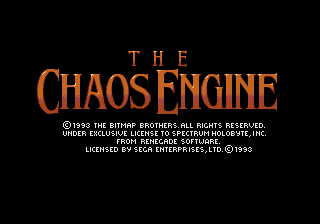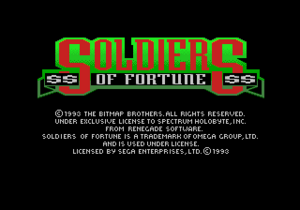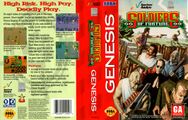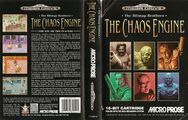Difference between revisions of "The Chaos Engine"
From Sega Retro
| Line 51: | Line 51: | ||
| playerone=91 | | playerone=91 | ||
| segamaguk=88 | | segamaguk=88 | ||
| + | | segapro=54 | ||
| + | | segapro_source={{num|36|page=54/55}} | ||
}} | }} | ||
{{Scanbox | {{Scanbox | ||
Revision as of 15:24, 27 February 2013
This short article is in need of work. You can help Sega Retro by adding to it.
| The Chaos Engine/Soldiers of Fortune | |||||
|---|---|---|---|---|---|
| System(s): Sega Mega Drive | |||||
| Publisher: Spectrum HoloByte (US), Microprose (EU) | |||||
| Developer: The Bitmap Brothers, Renegade | |||||
| Sound driver: Graftgold custom | |||||
| Genre: Action | |||||
| |||||
The Chaos Engine is a 1993 top-down run-and-gun game developed by The Bitmap Brothers for the Commodore Amiga and subsequently ported to a variety of platforms, including the SNES and Sega Mega Drive, ported by Renegade and published by Microprose in Europe and Spectrum HoloByte in the US, where the game was renamed Soldiers of Fortune and a character changed slightly. Its sequel was originally planned to receive a Mega Drive port but was cancelled during development.
Baron Fortesque, a brilliant scientist, invents The Chaos Engine, a primitive computer which goes mad and overtakes its creator to take over the world by altering humans and animals into beasts, among other terrors. Six mercenaries — heroes who are paid to fight — appear to save the day. You control two of the six heroes (who have to be hired by paying for them beforehand from a character select screen) as they try to get through the wasteland Earth has become and destroy The Chaos Engine. The game can be played either with one player and a CPU or two players simultaneously; in either case you must choose characters for both players.
Hold ![]() to fire. You cannot move as you fire; instead you use the D-pad to aim your shots, allowing you to hit targets in eight directions. There are four worlds, each with four levels. To get through each level, you must activate Nodes by shooting at them several times. A Node appears as a white tower with an orange blob on it; shooting it will turn into an electrified golden tower, activating it. You will also find gold, special weapons (fired with
to fire. You cannot move as you fire; instead you use the D-pad to aim your shots, allowing you to hit targets in eight directions. There are four worlds, each with four levels. To get through each level, you must activate Nodes by shooting at them several times. A Node appears as a white tower with an orange blob on it; shooting it will turn into an electrified golden tower, activating it. You will also find gold, special weapons (fired with ![]() ), keys to activate passageways, and yin-yang signs which act as checkpoints, among other items; walk into them to take them. Once all the Nodes have been activated, an exit will be activated, allowing you to leave the level. After every two levels, you are taken to a shop where you can spend gold to upgrade your characters.
), keys to activate passageways, and yin-yang signs which act as checkpoints, among other items; walk into them to take them. Once all the Nodes have been activated, an exit will be activated, allowing you to leave the level. After every two levels, you are taken to a shop where you can spend gold to upgrade your characters.
Production Credits
- Design: Simon Knight, Eric Matthews
- Graphic Design: Daniel Malone
- Graphic Conversion: Herman Seranno
- Original Code: Stephen Cargill
- Code Conversion: Glyn Kendall
- Additional Code: Mike Montgomery
- Original Game Music: Richard Joseph
- SFX: Richard Joseph
- Sound Conversion: Jason Page (at Graftgold)
- Title Music: Farook Joi, Haroon Joi
- Project Management: Graeme Boxall
Physical Scans
| 80 | |
|---|---|
| Based on 34 reviews | |
- ↑ 1700 igr dlya Sega, "" (RU; 2001-xx-xx), page 212
- ↑ Console Mania, "Febbraio 1994" (IT; 1994-0x-xx), page 95
- ↑ Consoles +, "Juillet/Août 1994" (FR; 1994-0x-xx), page 122
- ↑ Cool Gamer, "9" (RU; 2002-10-13), page 192
- ↑ Computer & Video Games, "May 1994" (UK; 1994-04-15), page 102
- ↑ Electronic Gaming Monthly, "February 1994" (US; 199x-xx-xx), page 40
- ↑ Entsiklopediya luchshikh igr Sega. Vypusk 1, "" (RU; 1999-xx-xx), page 359
- ↑ Entsiklopediya luchshikh igr Sega. Vypusk 9, "" (RU; 2002-xx-xx), page 48
- ↑ GameFan, "Volume 2, Issue 1: December 1993" (US; 1993-xx-xx), page 28
- ↑ GamePro, "December 1993" (US; 1993-xx-xx), page 65
- ↑ GamesMaster, "April 1994" (UK; 1994-03-17), page 38
- ↑ Game Informer, "January/February 1994" (US; 199x-xx-xx), page 44
- ↑ Hyper, "July 1994" (AU; 1994-xx-xx), page 36
- ↑ Joypad, "Juillet/Août 1994" (FR; 1994-0x-xx), page 144
- ↑ MAN!AC, "07/94" (DE; 1994-06-08), page 70
- ↑ Sega Mega Drive Advanced Gaming, "May 1994" (UK; 1994-xx-xx), page 44
- ↑ Mega, "April 1994" (UK; 1994-03-17), page 28
- ↑ Mega Force, "Juillet/Août 1994" (FR; 1994-07-04), page 82
- ↑ Mega Fun, "12/94" (DE; 1994-11-23), page 124
- ↑ MegaTech, "April 1994" (UK; 1994-03-18), page 68
- ↑ Mean Machines Sega, "April 1994" (UK; 1994-02-28), page 50
- ↑ Player One, "Juillet/Août 1994" (FR; 1994-0x-xx), page 98
- ↑ Play Time, "8/94" (DE; 1994-07-16), page 138
- ↑ Power Up!, "Saturday, July 02, 1994" (UK; 1994-07-02), page 1
- ↑ Sega Magazine, "June 1994" (UK; 1994-05-15), page 94
- ↑ Sega Magazine, "August 1994" (UK; 1994-07-15), page 95
- ↑ Sega News, "Prosinec 1996" (CZ; 1996-1x-xx), page 26
- ↑ Sega Power, "March 1994" (UK; 1994-02-03), page 42
- ↑ Sega Pro, "September 1994" (UK; 1994-08-11), page 54
- ↑ Sega Megazone, "September 1994" (AU; 1994-0x-xx), page 34
- ↑ Todo Sega, "Julio 1994" (ES; 1994-0x-xx), page 40
- ↑ Tricks, "2/95" (RU; 1995-xx-xx), page 17
- ↑ Tricks 16 bit, "Tricks Sega Gold 800 igr" (RU; 1998-03-20), page 10
- ↑ VideoGames, "December 1993" (US; 1993-1x-xx), page 102
- Stubs
- No players field
- Old content rating field
- Use romtable template
- All games
- Old-style rating (consolesplus)
- Rating without PDF source
- Old-style rating (egm)
- Rating without source
- Old-style rating (joypad)
- Old-style rating (megaforce)
- Old-style rating (mms)
- Old-style rating (playerone)
- Old-style rating (segamaguk)
- Old-style rating (segapro)
- Update ratings template
- 8 old ratings



